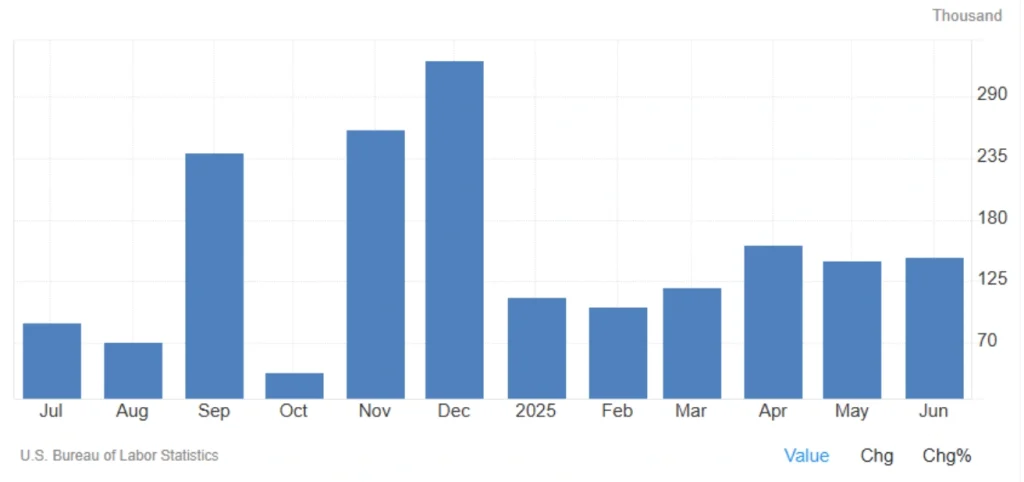
US Jobs Report in June Beats Expectations
- Nonfarm payrolls rose by 147,000 in June, beating expectations of 110,000
- Strong growth led by public sector hiring, especially in education
- Healthcare and social assistance sectors remain steady engines of job creation
- The U.S. job market continues to show strength and resilience despite political and trade headwinds
June 2025 Jobs Report Breakdown
| Sector | Change (in thousands) |
|---|---|
| Total NFP | +147 |
| May (revised) | +144 |
| Market forecast | +110 |
| 12-month average | +146 |
| Public Sector (Total) | +73 |
| State Government (Education) | +40 |
| Local Government (Education) | +23 |
| Federal Government | -7 |
| Healthcare Sector | +39 |
| – Hospitals | +16 |
| – Long-Term Care | +14 |
| Social Assistance | +19 |
Educational Insight: What Is Nonfarm Payrolls (NFP)?
Nonfarm Payrolls (NFP) is one of the most important monthly indicators of the U.S. labor market. It measures the number of jobs added or lost in all sectors excluding agriculture.
Published by the Bureau of Labor Statistics (BLS), NFP data strongly influences:
- 📉 Interest rate decisions by the Federal Reserve
- 📊 Short-term market movements in stocks, currencies, and gold
- 💼 Investor sentiment regarding U.S. economic health
Market Analysis: Solid Growth, but with Uneven Drivers

June’s stronger-than-expected job growth highlights the U.S. economy’s ongoing resilience in the face of tariffs, geopolitical tensions, and immigration policy uncertainty.
However, the bulk of growth came from state and local government hiring, especially in education, rather than private industry.
📉 Federal government employment continues to decline (down 69,000 jobs since January) possibly signaling federal budget-tightening.
Meanwhile, the healthcare and social assistance sectors remain steady, aligning closely with the 12-month job growth trend. Yet, hiring in private industry overall may slow down as businesses adopt a more cautious stance in response to global trade and policy uncertainty.
Investor Outlook & Recommendations
The data suggests that:
- The Fed is unlikely to rush into rate cuts, as there’s no sign of labor market weakness
- Bond markets may react neutrally or slightly bullish
- The U.S. dollar could remain stable or firm against major currencies
🔍 Key Takeaways for Investors:
- Watch upcoming reports on unemployment, wage growth, and inflation for a fuller picture of economic momentum
- Monitor Fed commentary for any signs of policy shifts heading into Q3
- Consider defensive positioning in sectors like healthcare and utilities, which show labor stability
Final Thoughts
The June NFP report confirms that the U.S. economy is still creating jobs but where and how jobs are added matters. While public hiring is booming, private sector trends warrant close attention.
For now, the U.S. labor market remains a pillar of strength but investors should stay alert for early signs of cooling in consumer-driven sectors.
Share
Hot topics

Will 2026 Be a Turning Point for Crypto Regulation in the U.S.?
The cryptocurrency world is gearing up for a transformative year as a pro-crypto administration, led by Donald Trump, prepares to take charge in the United States. With a Congress expected...
Read more




Submit comment
Your email address will not be published. Required fields are marked *